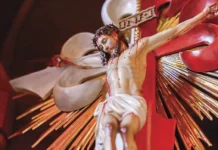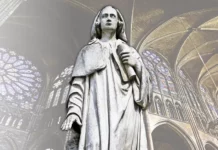A volume published for the occasion of the 100th anniversary of the First World War reproduces some eloquent testimonies of interventions of St. Thérèse in aid of soldiers who had recourse to her.
In the deluge of fire and steel that assailed Europe between 1914 and 1918, there was no dearth of touching episodes of faith. Among these stands out the unexpected outpouring of veneration, among the poilus,1 for a humble nun who died in the odour of sanctity in 1897: St. Thérèse of the Child Jesus and the Holy Face.
The Carmelite monastery of Lisieux, where she made the holocaust of her life to the merciful love of God, has more than two thousand dossiers containing handwritten letters received during the conflict, as well as decorations, medals, bullets, helmets and howitzers transformed into ex-votos.
To commemorate the first centenary of the outbreak of this war, a prestigious French publishing house has launched, in collaboration with the convent, a 203-page volume2 containing a selection of 75 of these little-known letters. Below, we transcribe a few.
I departed without confessing
I have been blessed by little Thérèse of the Child Jesus and I have great confidence in her. I visited her tomb in May of 1914 and returned very impressed. But, war having been declared, I refused to heed the insistent requests of my wife and I departed without confessing. Human respect prevented me from fulfilling my Catholic duty.
I had been away from the Church since my First Communion. However, I did accept a relic and a small image of the little Sister, and instinctively turned to her whenever I found myself in danger during the fighting. And she protected me, and my comrades also, for not one of them died or was wounded at my side.
In mid-September, I was in the trenches of Gotha, near Reims, in a difficult situation, for the artillery roared unceasingly. The thought of my young family made me very sad, and I prayed: “My Sister Thérèse, I beseech you, bring me back to my wife and children and I promise to visit your tomb immediately after returning to my homeland.”
I had barely finished this prayer when I saw a cloud open and in the blue sky appeared the face of the saint. I thought I was hallucinating. I rubbed my eyes several times, looking at the vision again, but there was no doubt, for her features became increasingly clear and resplendent. I contemplated her in this way for about two minutes. What especially caught my attention were her beautiful eyes, raised to Heaven as if in prayer.
From then on, I was always courageous; I never felt alone. I also had the sure hope of returning to my family and I made the unshakable resolution to return to the God of my childhood.
In fact, a short time later, I was withdrawn from the front because of illness and brought to the hospital; while I was there, someone asked if anyone wanted to receive Communion, and I did not have the least fear of expressing my desire.3

“I owe this to my little Sister Thérèse!”
From the beginning of the war, I kept a relic of Sister Thérèse with me. This is what happened to me. On the last day of the battle in the Marne region, in September, we had only eight cannons, against 25 of the enemy. At this critical moment, our ammunition ran out and, in the haste to have another battery come forward to replace ours, I fell, and my cannon ran over my two legs. They should have been completely crushed, for each cannon weighs more than two tonnes!
My dear companions in arms came running to carry me away. However, great was their astonishment to see me get up without difficulty! “Miracle! Miracle!”, they all shouted. I quickly replied, with my heart overflowing with gratitude: “I owe this to my little Sister Thérèse!” Immediately I took a white piece of chalk from my pocket and wrote in bold letters on my cannon: Sister Thérèse of the Child Jesus Battery.
And from that time on, whenever it rained and the inscription disappeared, I would rewrite it as quickly as possible. I have unlimited confidence in the protection of this saint.4

Grenade shrapnel in the chest
I swear, under oath, that I owe my life to Sister Thérèse of the Child Jesus. On March 16, 1916, on the eve of my second departure for the front, one of my comrades gave me a picture of the little saint, telling me: “It seems that she has already worked many miracles on behalf of the soldiers, and she protects us.” I had not known her up until then, but from that day onward, I invoked her every night without fail, praying an Our Father and a Hail Mary in her honour.
Shortly afterwards, on April 30, I participated in the bloody battle of Mort-Homme, in Verdun. During the terrible combat, I prayed to Sister Thérèse as I fought. I turned to her, not out of fear, for I was never afraid, but I asked her to sustain my courage, something truly necessary at that tragic moment! Suddenly, in the confusion of the battle, 20 metres from the enemy, I was hit in the middle of my chest by grenade shrapnel. I passed out, and when I came to my senses, the battle was still raging. Exhausted and losing blood, I did not have the strength to drag myself away. But, remembering my holy Protectress, I shouted: “Sister Thérèse of the Child Jesus, do not abandon me!”
And she heard my supplication, for under the machine gun volleys, the stretcher-bearers soon arrived and carried me to the first medical post. There, a courageous chaplain, who considered my case a serious one, gave me Extreme Unction, in the midst of the roar of the cannons. Despite the pain, I felt happy and thought, with gratitude, that I owed this religious assistance to Sister Thérèse. I had such confidence in the beloved little saint that, once I was sheltered from the bullets, I asked her for a second miracle: that she cure me and lead me to her tomb, in Lisieux. And I was answered. […]
Now I feel ready for any sacrifice, for every suffering, for the saint helped me to understand that in this way I would expiate my sins and furthermore, that Jesus Christ suffered much more for us.5
* * *
Exactly one century has passed since the beginning of the terrible war and the devotion to the Saint of the Little Way has grown and spread across the world. Pius XI canonized her in 1925, only 28 years after her death. And in 1997, Pope John Paul II proclaimed her a Doctor of the Church.
Faithful to her promise to spend Heaven doing good on earth, she has especially favoured the younger generations that stand in so much need of spiritual help because of their marked weakness. ◊
Notes







